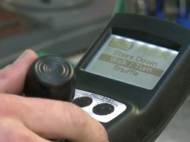REX Bionics robotic exoskeleton Rex could aid to paraplegics
 We already wrote several articles regarding exoskeletons as HULC, HAL-5 and power suit developed for elder Japanese farmers, however, the exoskeleton described in this article differs in its main porpoise. A robotic exoskeleton called Rex puts wheelchair users back on their feet, enabling a person to stand, walk and go up and down the stairs and slopes. That feature could prove useful, since sitting in a wheelchair for extended periods can also lead to the increased risk of certain infections and blood circulation problems.
We already wrote several articles regarding exoskeletons as HULC, HAL-5 and power suit developed for elder Japanese farmers, however, the exoskeleton described in this article differs in its main porpoise. A robotic exoskeleton called Rex puts wheelchair users back on their feet, enabling a person to stand, walk and go up and down the stairs and slopes. That feature could prove useful, since sitting in a wheelchair for extended periods can also lead to the increased risk of certain infections and blood circulation problems.
When Robert Irving was diagnosed with Multiple Sclerosis it was the catalyst for him and his childhood friend, Richard Little, to put turn their engineering skills to the task of developing an exoskeleton that was a practical standing and walking alternative to wheelchairs. Little and Irving formed a company called REX Bionics which produces the Rex in Auckland, New Zealand.
The result is Rex, an exoskeleton made of strong, yet lightweight materials that is designed to support and hold a person comfortably as they move. It weights approximately 38 kg (84 pounds).Users strap themselves in to the robotic legs with a number of Velcro and buckled straps that fit around the legs along with a belt that fits around the user’s waist. Since this exoskeleton is designed to help the paraplegics rather than enhancing power, it is controlled with a joystick that sits at the wearer’s waist level.
Users wearing Rex can stand up, walk, move sideways, turn around, go up and down stairs, as well as walk on flat, hard surfaces including ramps and slopes. It is designed for use on solid, stable surfaces such as those inside the home or workplace. It is not designed for use on slippery, unstable, or soft surfaces, on in areas that contain debris or small objects, such as ice, snow, sand, grass, mud or gravel.
Rex is designed to climb steps that meet typical building code standards for staircases – a minimum tread of 310 mm (12.2in), a maximum riser of 180mm (7in). It can walk on a curbed slope of up to 1:8 (7.1 degrees) and a general slope of up to 1:12 (4.8 degrees). It is powered by a custom-made rechargeable battery that will typically provide two hours of active use on a full charge. To extend running time the battery can be easily swapped out for a fully charged one.
Before purchasing the Rex, potential customers will need to complete a medical check with their own physician as well as a series of checks for range of motion with a qualified physical therapist to ensure they have no contraindications to standing and walking. To meet Rex’s balance and loading constraints, customers will also need to be between 4’8” (146cm) and 6’4” (195cm) tall, with a weight of less than 220lb (100kg) and a hip girth of less than 14.9” (380mm). REX Bionics will also provide full training and a customized fitting over the course of approximately two weeks for buyers of the device.
The company says Rex is only really suitable for manual wheelchair users who can self-transfer and operate hand controls and Rex’s developers are quick to point out that REX is not intended as a replacement for a wheelchair, but as a complement to a wheelchair.
The company is in the process of concluding all the tests required prior to putting Rex on the market in Europe and Australia. It will also be seeking FDA approval so that Rex can be put on the market in the USA. REX Bionics CEO, Jenny Morel, says the company expects to conclude internal testing of Rex shortly and will then have a preliminary release in Auckland to allow the company to track what happens when people take Rex home. Sales are expected to commence in New Zealand by the end of 2010 and elsewhere by the middle of 2011.









author
It is expected that REX Bionics robotic exoskeleton Rex will cost about US$150,000.
my father is wheel chair bound and he is having neuro problem in the sense body and hand shakes will this device work
author
It should work if his hands are dexterous enough to control the joystick.